HI5020 Corporate Accounting: Funds, Assets, Liabilities Report
VerifiedAdded on 2022/08/18
|17
|3859
|10
Report
AI Summary
This report analyzes the sources of funds employed by Pelican Resource Limited and Rio Tinto PLC over three financial years, detailing the internal and external fund percentages. It examines the types of assets and liabilities presented in the balance sheets, including deferred tax liabilities, borrowings, and both interest-bearing and non-interest-bearing liabilities. The report explores the merits and shortcomings of different funding sources, such as retained earnings and preference shares. It then delves into the key provisions of AASB 137, covering contingent assets, contingent liabilities, and provisions, along with their implications. The classification of assets, including trade receivables and inventories, and their measurement bases are also discussed. The analysis highlights the financial strategies of both companies, their reliance on different funding methods, and their compliance with accounting standards, providing a comprehensive overview of their financial management practices.
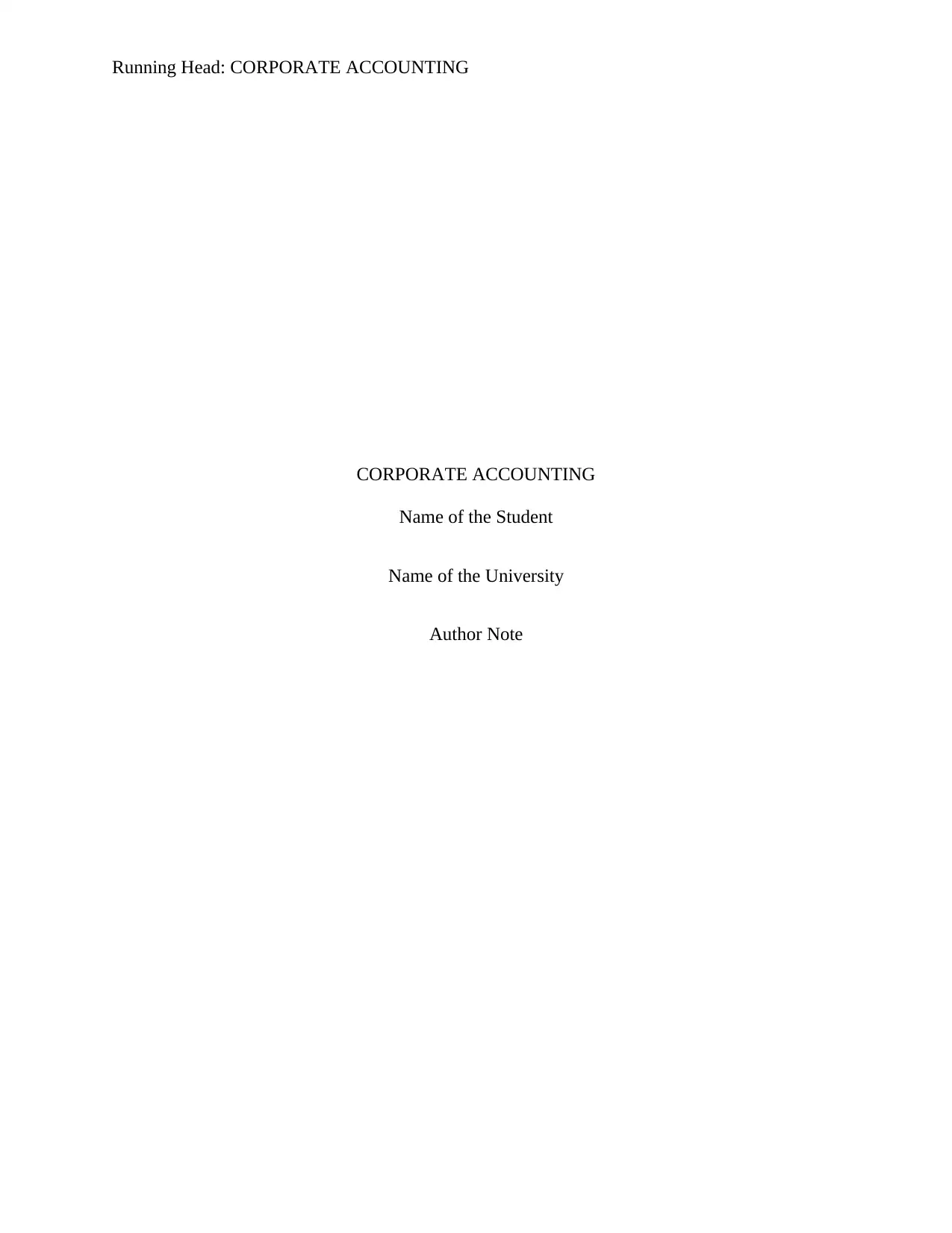
Running Head: CORPORATE ACCOUNTING
CORPORATE ACCOUNTING
Name of the Student
Name of the University
Author Note
CORPORATE ACCOUNTING
Name of the Student
Name of the University
Author Note
Paraphrase This Document
Need a fresh take? Get an instant paraphrase of this document with our AI Paraphraser
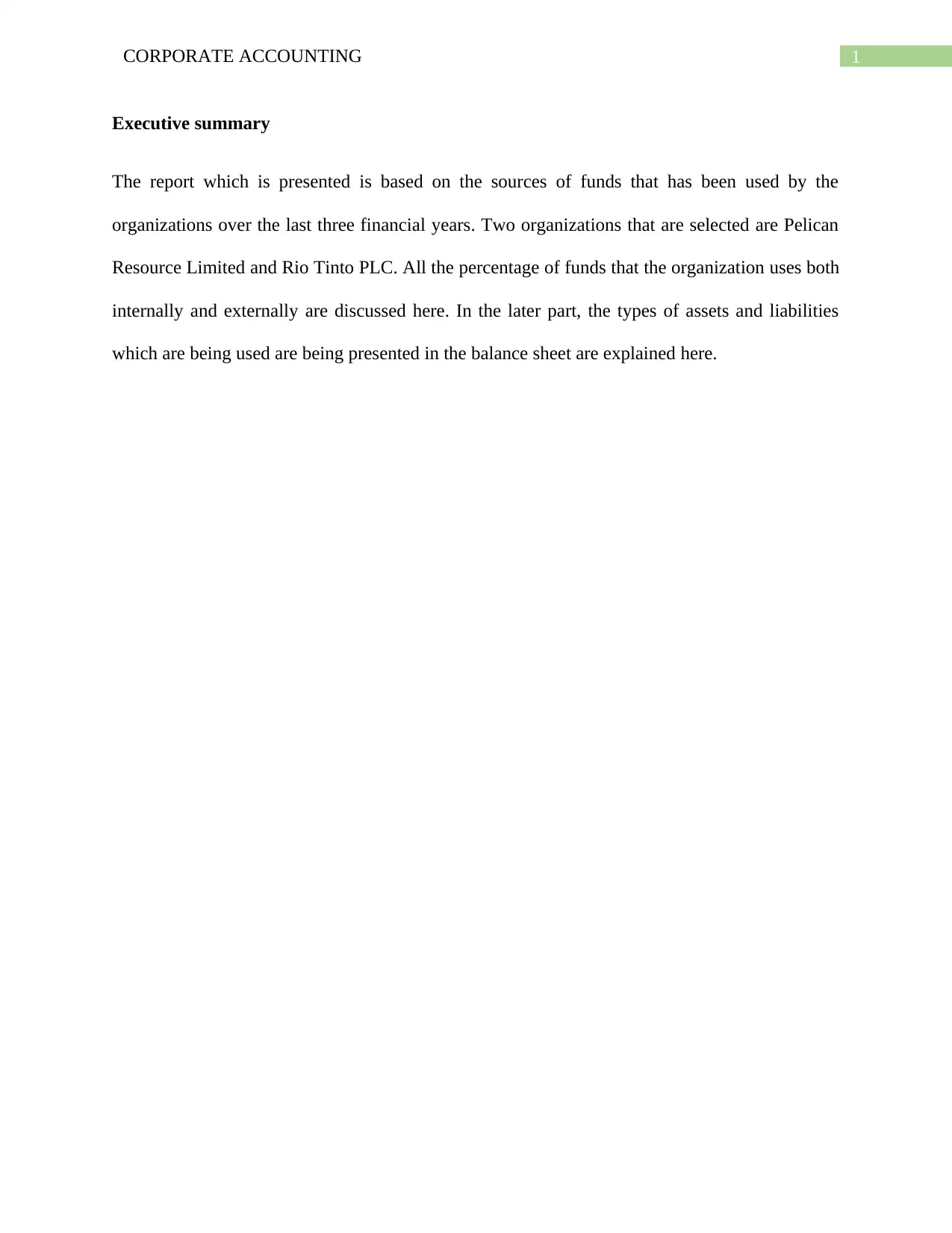
1CORPORATE ACCOUNTING
Executive summary
The report which is presented is based on the sources of funds that has been used by the
organizations over the last three financial years. Two organizations that are selected are Pelican
Resource Limited and Rio Tinto PLC. All the percentage of funds that the organization uses both
internally and externally are discussed here. In the later part, the types of assets and liabilities
which are being used are being presented in the balance sheet are explained here.
Executive summary
The report which is presented is based on the sources of funds that has been used by the
organizations over the last three financial years. Two organizations that are selected are Pelican
Resource Limited and Rio Tinto PLC. All the percentage of funds that the organization uses both
internally and externally are discussed here. In the later part, the types of assets and liabilities
which are being used are being presented in the balance sheet are explained here.
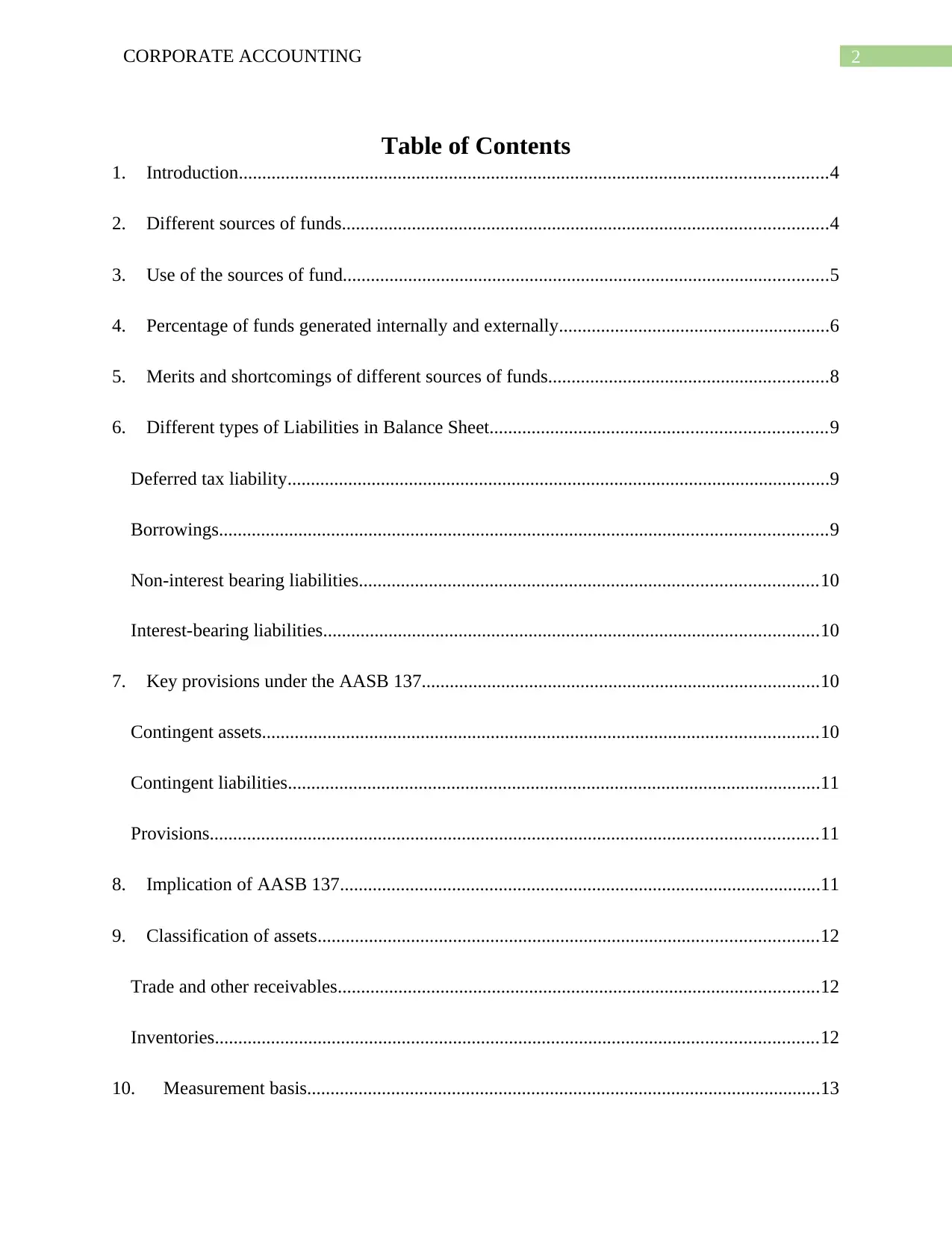
2CORPORATE ACCOUNTING
Table of Contents
1. Introduction..............................................................................................................................4
2. Different sources of funds........................................................................................................4
3. Use of the sources of fund........................................................................................................5
4. Percentage of funds generated internally and externally..........................................................6
5. Merits and shortcomings of different sources of funds............................................................8
6. Different types of Liabilities in Balance Sheet........................................................................9
Deferred tax liability....................................................................................................................9
Borrowings..................................................................................................................................9
Non-interest bearing liabilities..................................................................................................10
Interest-bearing liabilities..........................................................................................................10
7. Key provisions under the AASB 137.....................................................................................10
Contingent assets.......................................................................................................................10
Contingent liabilities..................................................................................................................11
Provisions..................................................................................................................................11
8. Implication of AASB 137.......................................................................................................11
9. Classification of assets...........................................................................................................12
Trade and other receivables.......................................................................................................12
Inventories.................................................................................................................................12
10. Measurement basis..............................................................................................................13
Table of Contents
1. Introduction..............................................................................................................................4
2. Different sources of funds........................................................................................................4
3. Use of the sources of fund........................................................................................................5
4. Percentage of funds generated internally and externally..........................................................6
5. Merits and shortcomings of different sources of funds............................................................8
6. Different types of Liabilities in Balance Sheet........................................................................9
Deferred tax liability....................................................................................................................9
Borrowings..................................................................................................................................9
Non-interest bearing liabilities..................................................................................................10
Interest-bearing liabilities..........................................................................................................10
7. Key provisions under the AASB 137.....................................................................................10
Contingent assets.......................................................................................................................10
Contingent liabilities..................................................................................................................11
Provisions..................................................................................................................................11
8. Implication of AASB 137.......................................................................................................11
9. Classification of assets...........................................................................................................12
Trade and other receivables.......................................................................................................12
Inventories.................................................................................................................................12
10. Measurement basis..............................................................................................................13
⊘ This is a preview!⊘
Do you want full access?
Subscribe today to unlock all pages.

Trusted by 1+ million students worldwide
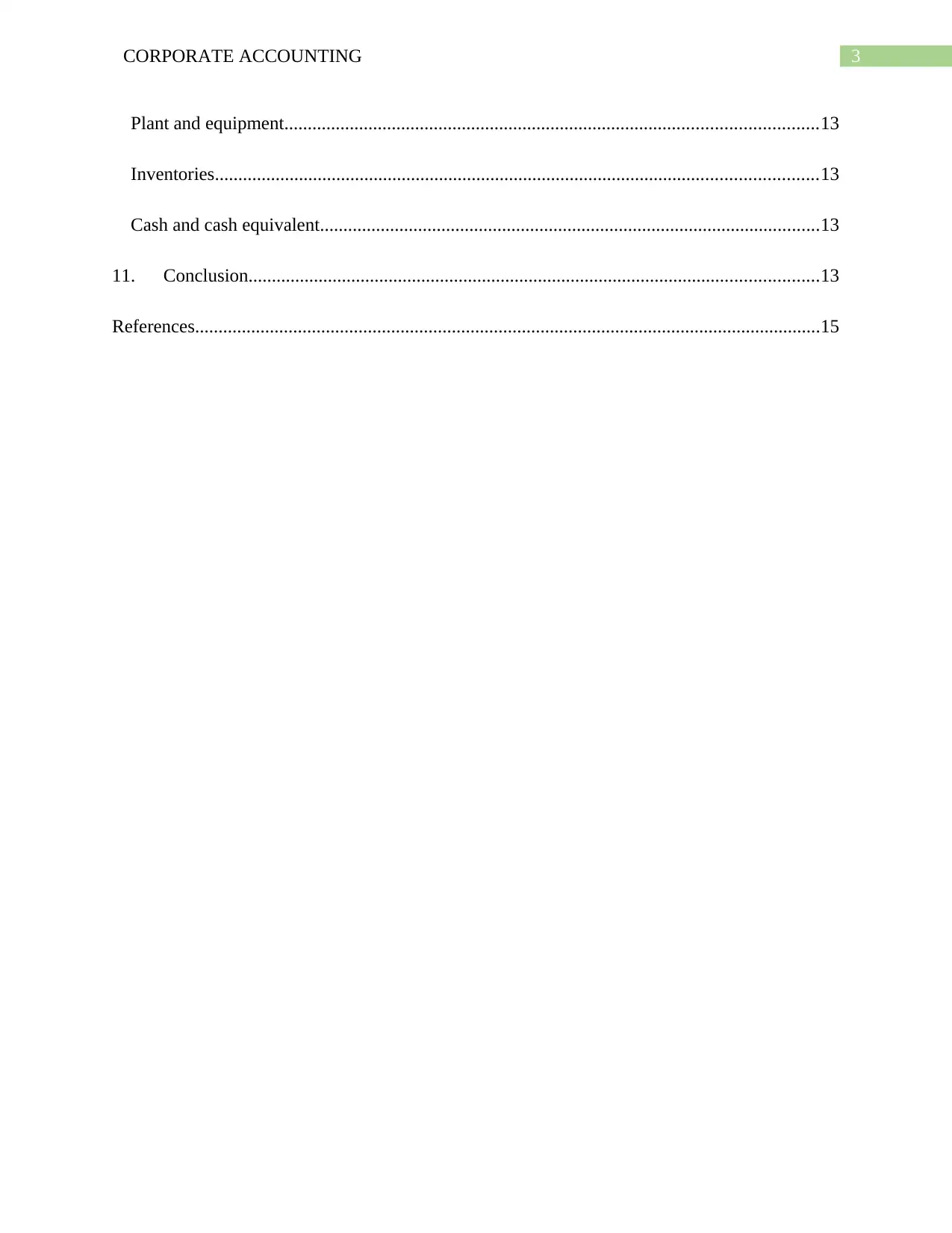
3CORPORATE ACCOUNTING
Plant and equipment..................................................................................................................13
Inventories.................................................................................................................................13
Cash and cash equivalent...........................................................................................................13
11. Conclusion..........................................................................................................................13
References......................................................................................................................................15
Plant and equipment..................................................................................................................13
Inventories.................................................................................................................................13
Cash and cash equivalent...........................................................................................................13
11. Conclusion..........................................................................................................................13
References......................................................................................................................................15
Paraphrase This Document
Need a fresh take? Get an instant paraphrase of this document with our AI Paraphraser
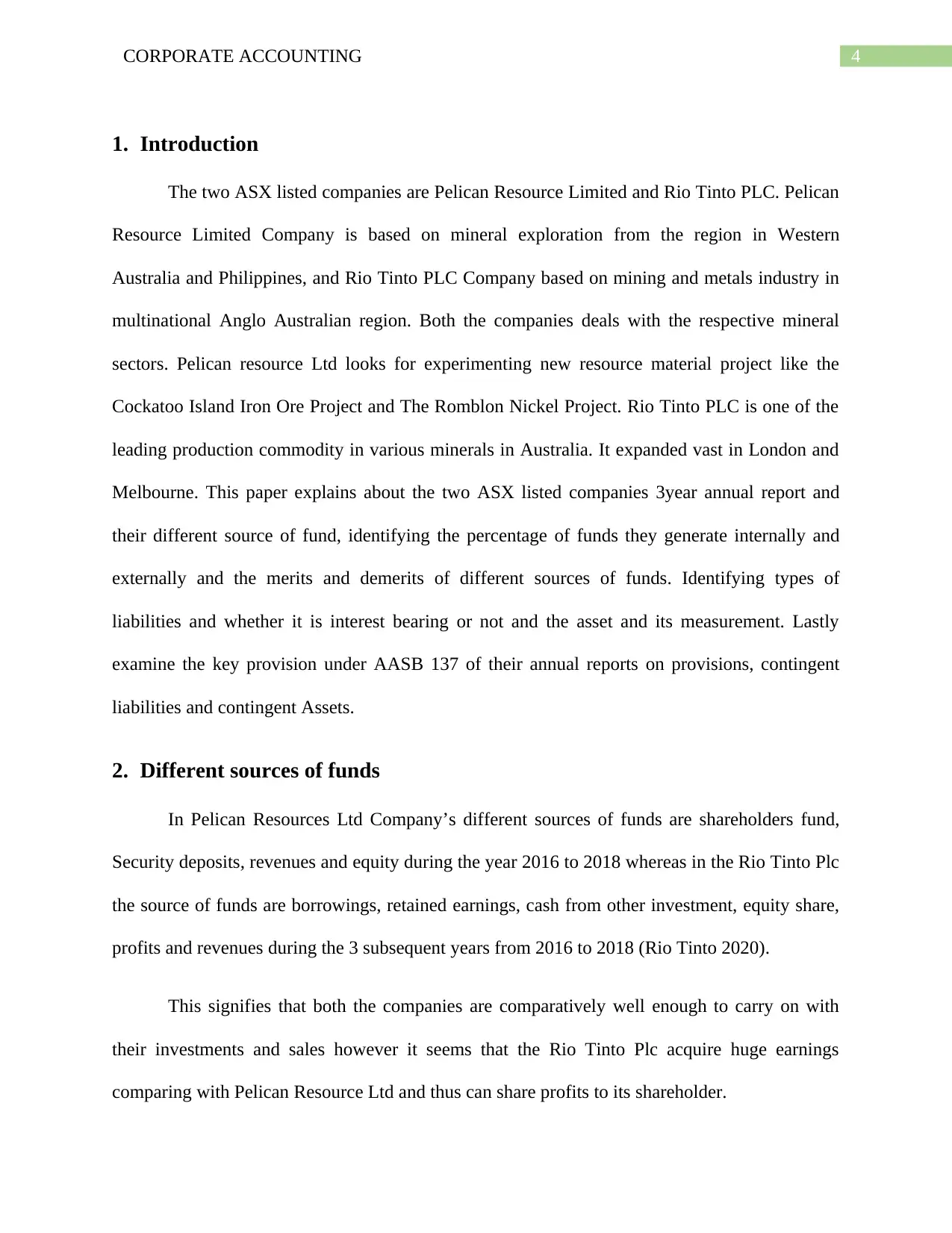
4CORPORATE ACCOUNTING
1. Introduction
The two ASX listed companies are Pelican Resource Limited and Rio Tinto PLC. Pelican
Resource Limited Company is based on mineral exploration from the region in Western
Australia and Philippines, and Rio Tinto PLC Company based on mining and metals industry in
multinational Anglo Australian region. Both the companies deals with the respective mineral
sectors. Pelican resource Ltd looks for experimenting new resource material project like the
Cockatoo Island Iron Ore Project and The Romblon Nickel Project. Rio Tinto PLC is one of the
leading production commodity in various minerals in Australia. It expanded vast in London and
Melbourne. This paper explains about the two ASX listed companies 3year annual report and
their different source of fund, identifying the percentage of funds they generate internally and
externally and the merits and demerits of different sources of funds. Identifying types of
liabilities and whether it is interest bearing or not and the asset and its measurement. Lastly
examine the key provision under AASB 137 of their annual reports on provisions, contingent
liabilities and contingent Assets.
2. Different sources of funds
In Pelican Resources Ltd Company’s different sources of funds are shareholders fund,
Security deposits, revenues and equity during the year 2016 to 2018 whereas in the Rio Tinto Plc
the source of funds are borrowings, retained earnings, cash from other investment, equity share,
profits and revenues during the 3 subsequent years from 2016 to 2018 (Rio Tinto 2020).
This signifies that both the companies are comparatively well enough to carry on with
their investments and sales however it seems that the Rio Tinto Plc acquire huge earnings
comparing with Pelican Resource Ltd and thus can share profits to its shareholder.
1. Introduction
The two ASX listed companies are Pelican Resource Limited and Rio Tinto PLC. Pelican
Resource Limited Company is based on mineral exploration from the region in Western
Australia and Philippines, and Rio Tinto PLC Company based on mining and metals industry in
multinational Anglo Australian region. Both the companies deals with the respective mineral
sectors. Pelican resource Ltd looks for experimenting new resource material project like the
Cockatoo Island Iron Ore Project and The Romblon Nickel Project. Rio Tinto PLC is one of the
leading production commodity in various minerals in Australia. It expanded vast in London and
Melbourne. This paper explains about the two ASX listed companies 3year annual report and
their different source of fund, identifying the percentage of funds they generate internally and
externally and the merits and demerits of different sources of funds. Identifying types of
liabilities and whether it is interest bearing or not and the asset and its measurement. Lastly
examine the key provision under AASB 137 of their annual reports on provisions, contingent
liabilities and contingent Assets.
2. Different sources of funds
In Pelican Resources Ltd Company’s different sources of funds are shareholders fund,
Security deposits, revenues and equity during the year 2016 to 2018 whereas in the Rio Tinto Plc
the source of funds are borrowings, retained earnings, cash from other investment, equity share,
profits and revenues during the 3 subsequent years from 2016 to 2018 (Rio Tinto 2020).
This signifies that both the companies are comparatively well enough to carry on with
their investments and sales however it seems that the Rio Tinto Plc acquire huge earnings
comparing with Pelican Resource Ltd and thus can share profits to its shareholder.
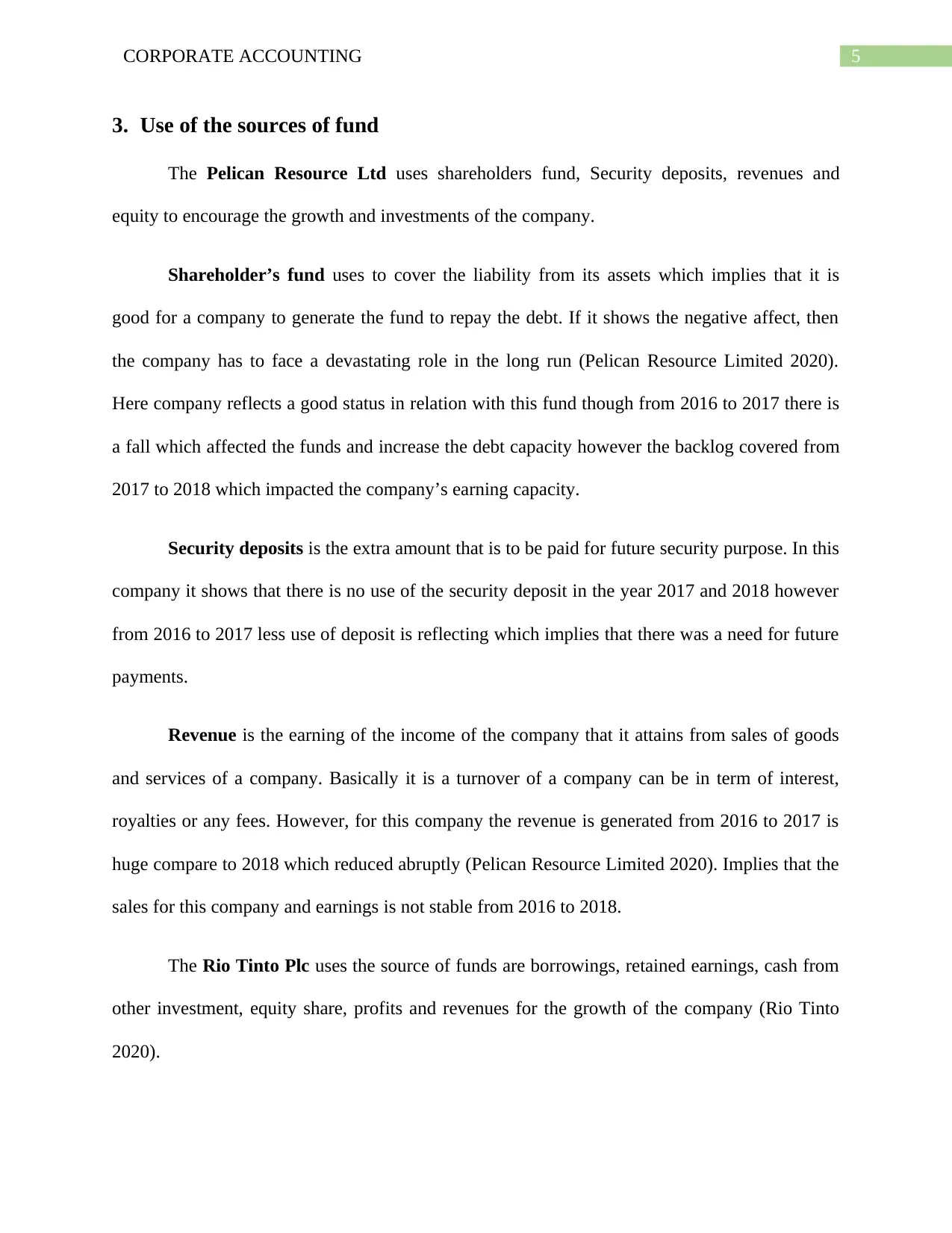
5CORPORATE ACCOUNTING
3. Use of the sources of fund
The Pelican Resource Ltd uses shareholders fund, Security deposits, revenues and
equity to encourage the growth and investments of the company.
Shareholder’s fund uses to cover the liability from its assets which implies that it is
good for a company to generate the fund to repay the debt. If it shows the negative affect, then
the company has to face a devastating role in the long run (Pelican Resource Limited 2020).
Here company reflects a good status in relation with this fund though from 2016 to 2017 there is
a fall which affected the funds and increase the debt capacity however the backlog covered from
2017 to 2018 which impacted the company’s earning capacity.
Security deposits is the extra amount that is to be paid for future security purpose. In this
company it shows that there is no use of the security deposit in the year 2017 and 2018 however
from 2016 to 2017 less use of deposit is reflecting which implies that there was a need for future
payments.
Revenue is the earning of the income of the company that it attains from sales of goods
and services of a company. Basically it is a turnover of a company can be in term of interest,
royalties or any fees. However, for this company the revenue is generated from 2016 to 2017 is
huge compare to 2018 which reduced abruptly (Pelican Resource Limited 2020). Implies that the
sales for this company and earnings is not stable from 2016 to 2018.
The Rio Tinto Plc uses the source of funds are borrowings, retained earnings, cash from
other investment, equity share, profits and revenues for the growth of the company (Rio Tinto
2020).
3. Use of the sources of fund
The Pelican Resource Ltd uses shareholders fund, Security deposits, revenues and
equity to encourage the growth and investments of the company.
Shareholder’s fund uses to cover the liability from its assets which implies that it is
good for a company to generate the fund to repay the debt. If it shows the negative affect, then
the company has to face a devastating role in the long run (Pelican Resource Limited 2020).
Here company reflects a good status in relation with this fund though from 2016 to 2017 there is
a fall which affected the funds and increase the debt capacity however the backlog covered from
2017 to 2018 which impacted the company’s earning capacity.
Security deposits is the extra amount that is to be paid for future security purpose. In this
company it shows that there is no use of the security deposit in the year 2017 and 2018 however
from 2016 to 2017 less use of deposit is reflecting which implies that there was a need for future
payments.
Revenue is the earning of the income of the company that it attains from sales of goods
and services of a company. Basically it is a turnover of a company can be in term of interest,
royalties or any fees. However, for this company the revenue is generated from 2016 to 2017 is
huge compare to 2018 which reduced abruptly (Pelican Resource Limited 2020). Implies that the
sales for this company and earnings is not stable from 2016 to 2018.
The Rio Tinto Plc uses the source of funds are borrowings, retained earnings, cash from
other investment, equity share, profits and revenues for the growth of the company (Rio Tinto
2020).
⊘ This is a preview!⊘
Do you want full access?
Subscribe today to unlock all pages.

Trusted by 1+ million students worldwide
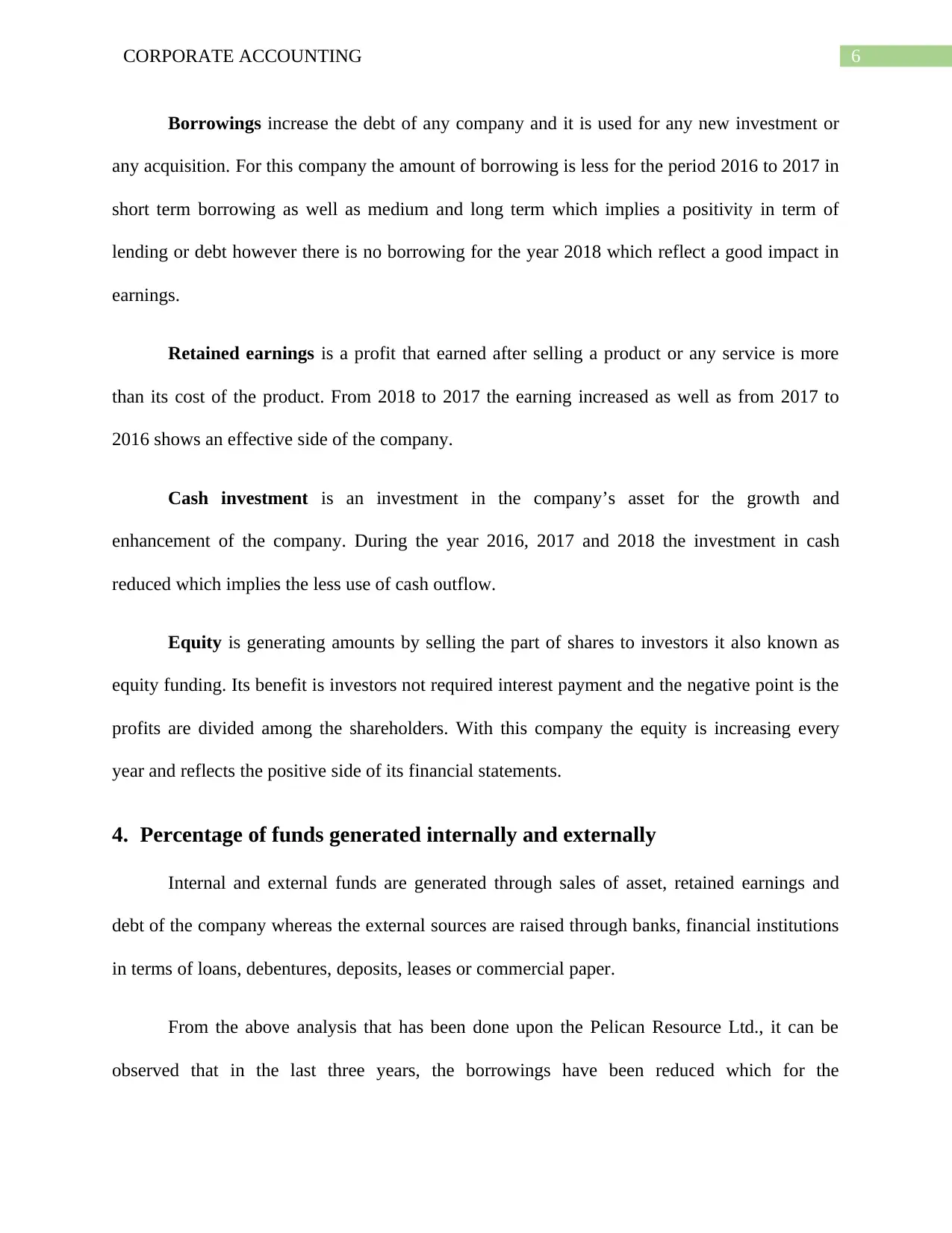
6CORPORATE ACCOUNTING
Borrowings increase the debt of any company and it is used for any new investment or
any acquisition. For this company the amount of borrowing is less for the period 2016 to 2017 in
short term borrowing as well as medium and long term which implies a positivity in term of
lending or debt however there is no borrowing for the year 2018 which reflect a good impact in
earnings.
Retained earnings is a profit that earned after selling a product or any service is more
than its cost of the product. From 2018 to 2017 the earning increased as well as from 2017 to
2016 shows an effective side of the company.
Cash investment is an investment in the company’s asset for the growth and
enhancement of the company. During the year 2016, 2017 and 2018 the investment in cash
reduced which implies the less use of cash outflow.
Equity is generating amounts by selling the part of shares to investors it also known as
equity funding. Its benefit is investors not required interest payment and the negative point is the
profits are divided among the shareholders. With this company the equity is increasing every
year and reflects the positive side of its financial statements.
4. Percentage of funds generated internally and externally
Internal and external funds are generated through sales of asset, retained earnings and
debt of the company whereas the external sources are raised through banks, financial institutions
in terms of loans, debentures, deposits, leases or commercial paper.
From the above analysis that has been done upon the Pelican Resource Ltd., it can be
observed that in the last three years, the borrowings have been reduced which for the
Borrowings increase the debt of any company and it is used for any new investment or
any acquisition. For this company the amount of borrowing is less for the period 2016 to 2017 in
short term borrowing as well as medium and long term which implies a positivity in term of
lending or debt however there is no borrowing for the year 2018 which reflect a good impact in
earnings.
Retained earnings is a profit that earned after selling a product or any service is more
than its cost of the product. From 2018 to 2017 the earning increased as well as from 2017 to
2016 shows an effective side of the company.
Cash investment is an investment in the company’s asset for the growth and
enhancement of the company. During the year 2016, 2017 and 2018 the investment in cash
reduced which implies the less use of cash outflow.
Equity is generating amounts by selling the part of shares to investors it also known as
equity funding. Its benefit is investors not required interest payment and the negative point is the
profits are divided among the shareholders. With this company the equity is increasing every
year and reflects the positive side of its financial statements.
4. Percentage of funds generated internally and externally
Internal and external funds are generated through sales of asset, retained earnings and
debt of the company whereas the external sources are raised through banks, financial institutions
in terms of loans, debentures, deposits, leases or commercial paper.
From the above analysis that has been done upon the Pelican Resource Ltd., it can be
observed that in the last three years, the borrowings have been reduced which for the
Paraphrase This Document
Need a fresh take? Get an instant paraphrase of this document with our AI Paraphraser
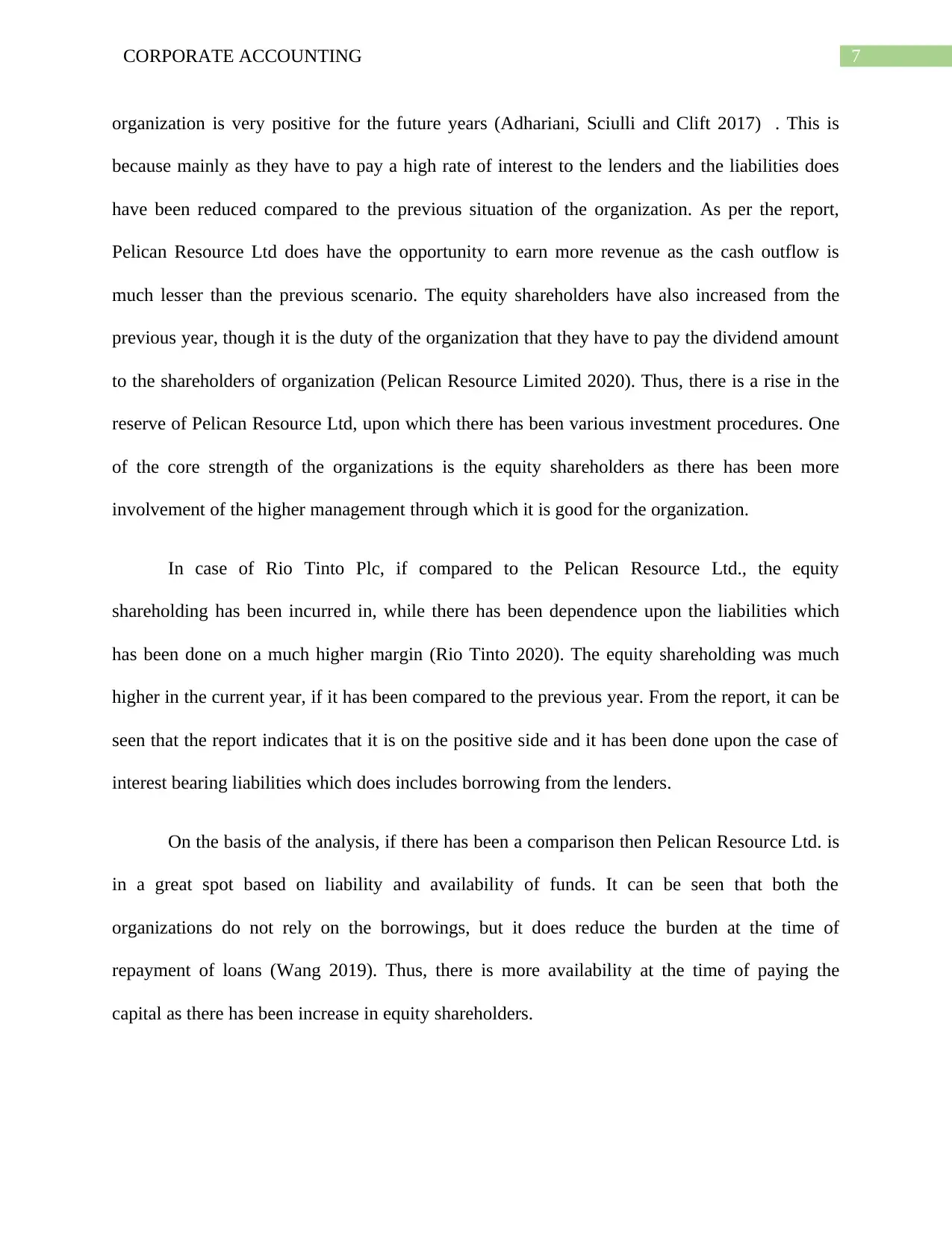
7CORPORATE ACCOUNTING
organization is very positive for the future years (Adhariani, Sciulli and Clift 2017) . This is
because mainly as they have to pay a high rate of interest to the lenders and the liabilities does
have been reduced compared to the previous situation of the organization. As per the report,
Pelican Resource Ltd does have the opportunity to earn more revenue as the cash outflow is
much lesser than the previous scenario. The equity shareholders have also increased from the
previous year, though it is the duty of the organization that they have to pay the dividend amount
to the shareholders of organization (Pelican Resource Limited 2020). Thus, there is a rise in the
reserve of Pelican Resource Ltd, upon which there has been various investment procedures. One
of the core strength of the organizations is the equity shareholders as there has been more
involvement of the higher management through which it is good for the organization.
In case of Rio Tinto Plc, if compared to the Pelican Resource Ltd., the equity
shareholding has been incurred in, while there has been dependence upon the liabilities which
has been done on a much higher margin (Rio Tinto 2020). The equity shareholding was much
higher in the current year, if it has been compared to the previous year. From the report, it can be
seen that the report indicates that it is on the positive side and it has been done upon the case of
interest bearing liabilities which does includes borrowing from the lenders.
On the basis of the analysis, if there has been a comparison then Pelican Resource Ltd. is
in a great spot based on liability and availability of funds. It can be seen that both the
organizations do not rely on the borrowings, but it does reduce the burden at the time of
repayment of loans (Wang 2019). Thus, there is more availability at the time of paying the
capital as there has been increase in equity shareholders.
organization is very positive for the future years (Adhariani, Sciulli and Clift 2017) . This is
because mainly as they have to pay a high rate of interest to the lenders and the liabilities does
have been reduced compared to the previous situation of the organization. As per the report,
Pelican Resource Ltd does have the opportunity to earn more revenue as the cash outflow is
much lesser than the previous scenario. The equity shareholders have also increased from the
previous year, though it is the duty of the organization that they have to pay the dividend amount
to the shareholders of organization (Pelican Resource Limited 2020). Thus, there is a rise in the
reserve of Pelican Resource Ltd, upon which there has been various investment procedures. One
of the core strength of the organizations is the equity shareholders as there has been more
involvement of the higher management through which it is good for the organization.
In case of Rio Tinto Plc, if compared to the Pelican Resource Ltd., the equity
shareholding has been incurred in, while there has been dependence upon the liabilities which
has been done on a much higher margin (Rio Tinto 2020). The equity shareholding was much
higher in the current year, if it has been compared to the previous year. From the report, it can be
seen that the report indicates that it is on the positive side and it has been done upon the case of
interest bearing liabilities which does includes borrowing from the lenders.
On the basis of the analysis, if there has been a comparison then Pelican Resource Ltd. is
in a great spot based on liability and availability of funds. It can be seen that both the
organizations do not rely on the borrowings, but it does reduce the burden at the time of
repayment of loans (Wang 2019). Thus, there is more availability at the time of paying the
capital as there has been increase in equity shareholders.
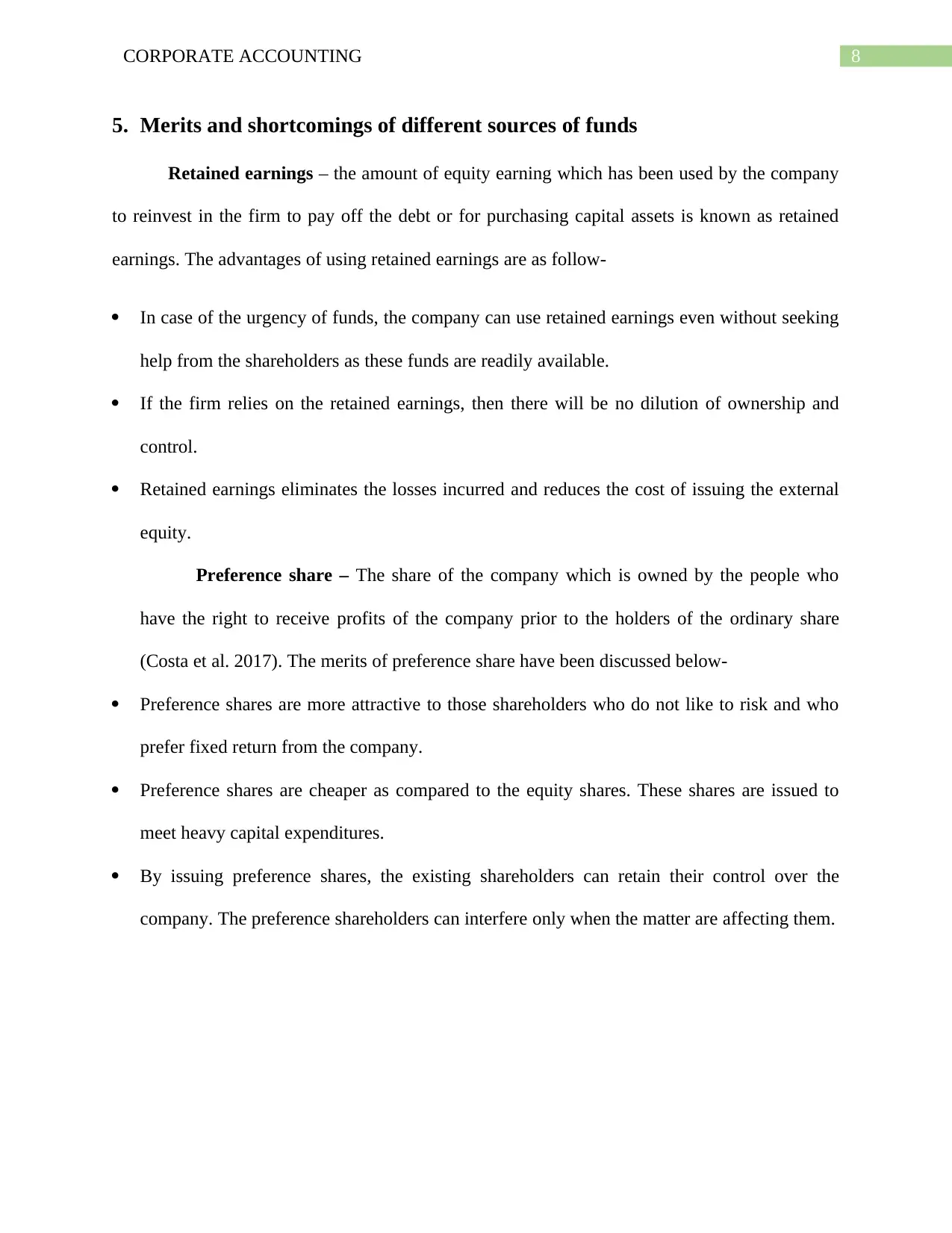
8CORPORATE ACCOUNTING
5. Merits and shortcomings of different sources of funds
Retained earnings – the amount of equity earning which has been used by the company
to reinvest in the firm to pay off the debt or for purchasing capital assets is known as retained
earnings. The advantages of using retained earnings are as follow-
In case of the urgency of funds, the company can use retained earnings even without seeking
help from the shareholders as these funds are readily available.
If the firm relies on the retained earnings, then there will be no dilution of ownership and
control.
Retained earnings eliminates the losses incurred and reduces the cost of issuing the external
equity.
Preference share – The share of the company which is owned by the people who
have the right to receive profits of the company prior to the holders of the ordinary share
(Costa et al. 2017). The merits of preference share have been discussed below-
Preference shares are more attractive to those shareholders who do not like to risk and who
prefer fixed return from the company.
Preference shares are cheaper as compared to the equity shares. These shares are issued to
meet heavy capital expenditures.
By issuing preference shares, the existing shareholders can retain their control over the
company. The preference shareholders can interfere only when the matter are affecting them.
5. Merits and shortcomings of different sources of funds
Retained earnings – the amount of equity earning which has been used by the company
to reinvest in the firm to pay off the debt or for purchasing capital assets is known as retained
earnings. The advantages of using retained earnings are as follow-
In case of the urgency of funds, the company can use retained earnings even without seeking
help from the shareholders as these funds are readily available.
If the firm relies on the retained earnings, then there will be no dilution of ownership and
control.
Retained earnings eliminates the losses incurred and reduces the cost of issuing the external
equity.
Preference share – The share of the company which is owned by the people who
have the right to receive profits of the company prior to the holders of the ordinary share
(Costa et al. 2017). The merits of preference share have been discussed below-
Preference shares are more attractive to those shareholders who do not like to risk and who
prefer fixed return from the company.
Preference shares are cheaper as compared to the equity shares. These shares are issued to
meet heavy capital expenditures.
By issuing preference shares, the existing shareholders can retain their control over the
company. The preference shareholders can interfere only when the matter are affecting them.
⊘ This is a preview!⊘
Do you want full access?
Subscribe today to unlock all pages.

Trusted by 1+ million students worldwide
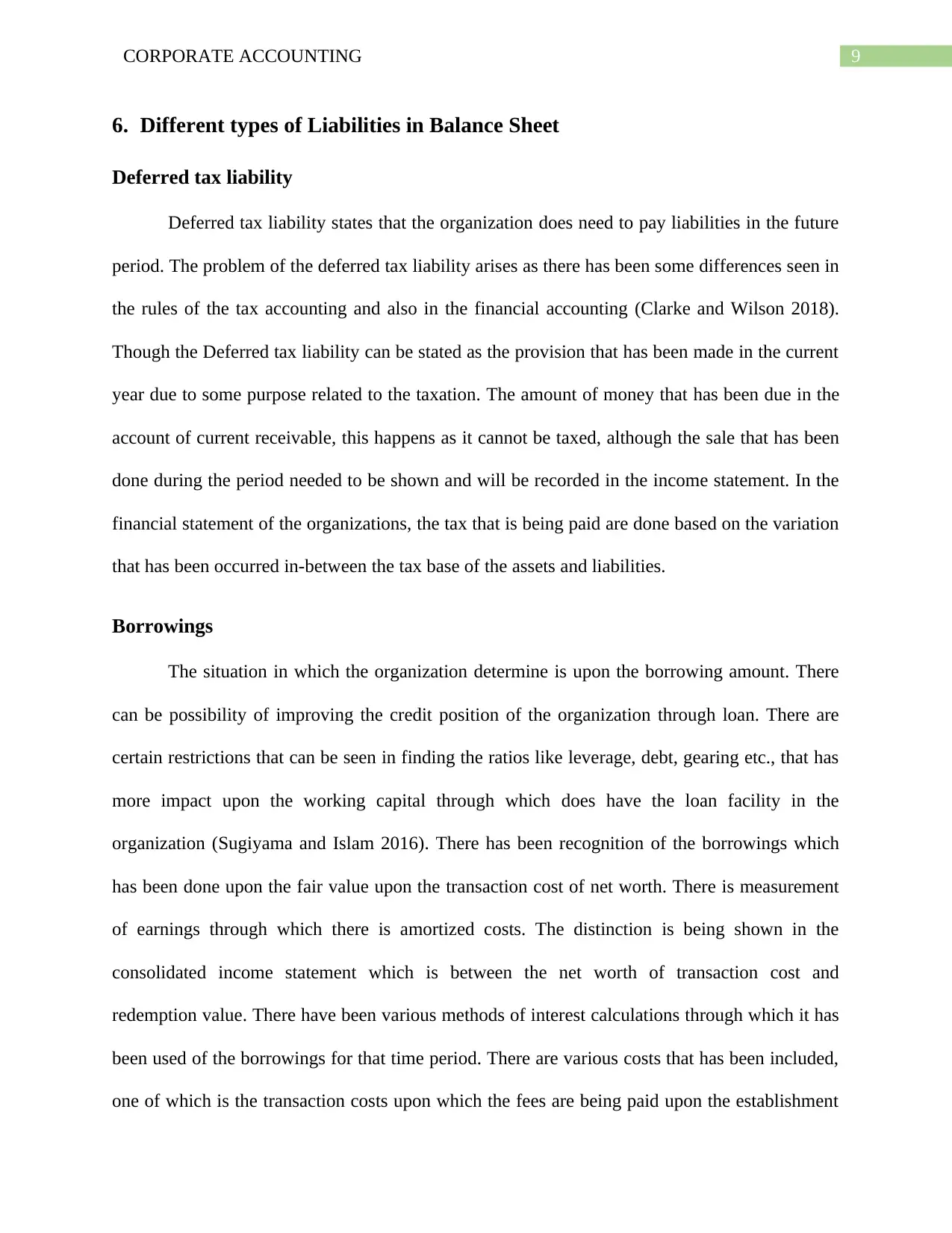
9CORPORATE ACCOUNTING
6. Different types of Liabilities in Balance Sheet
Deferred tax liability
Deferred tax liability states that the organization does need to pay liabilities in the future
period. The problem of the deferred tax liability arises as there has been some differences seen in
the rules of the tax accounting and also in the financial accounting (Clarke and Wilson 2018).
Though the Deferred tax liability can be stated as the provision that has been made in the current
year due to some purpose related to the taxation. The amount of money that has been due in the
account of current receivable, this happens as it cannot be taxed, although the sale that has been
done during the period needed to be shown and will be recorded in the income statement. In the
financial statement of the organizations, the tax that is being paid are done based on the variation
that has been occurred in-between the tax base of the assets and liabilities.
Borrowings
The situation in which the organization determine is upon the borrowing amount. There
can be possibility of improving the credit position of the organization through loan. There are
certain restrictions that can be seen in finding the ratios like leverage, debt, gearing etc., that has
more impact upon the working capital through which does have the loan facility in the
organization (Sugiyama and Islam 2016). There has been recognition of the borrowings which
has been done upon the fair value upon the transaction cost of net worth. There is measurement
of earnings through which there is amortized costs. The distinction is being shown in the
consolidated income statement which is between the net worth of transaction cost and
redemption value. There have been various methods of interest calculations through which it has
been used of the borrowings for that time period. There are various costs that has been included,
one of which is the transaction costs upon which the fees are being paid upon the establishment
6. Different types of Liabilities in Balance Sheet
Deferred tax liability
Deferred tax liability states that the organization does need to pay liabilities in the future
period. The problem of the deferred tax liability arises as there has been some differences seen in
the rules of the tax accounting and also in the financial accounting (Clarke and Wilson 2018).
Though the Deferred tax liability can be stated as the provision that has been made in the current
year due to some purpose related to the taxation. The amount of money that has been due in the
account of current receivable, this happens as it cannot be taxed, although the sale that has been
done during the period needed to be shown and will be recorded in the income statement. In the
financial statement of the organizations, the tax that is being paid are done based on the variation
that has been occurred in-between the tax base of the assets and liabilities.
Borrowings
The situation in which the organization determine is upon the borrowing amount. There
can be possibility of improving the credit position of the organization through loan. There are
certain restrictions that can be seen in finding the ratios like leverage, debt, gearing etc., that has
more impact upon the working capital through which does have the loan facility in the
organization (Sugiyama and Islam 2016). There has been recognition of the borrowings which
has been done upon the fair value upon the transaction cost of net worth. There is measurement
of earnings through which there is amortized costs. The distinction is being shown in the
consolidated income statement which is between the net worth of transaction cost and
redemption value. There have been various methods of interest calculations through which it has
been used of the borrowings for that time period. There are various costs that has been included,
one of which is the transaction costs upon which the fees are being paid upon the establishment
Paraphrase This Document
Need a fresh take? Get an instant paraphrase of this document with our AI Paraphraser
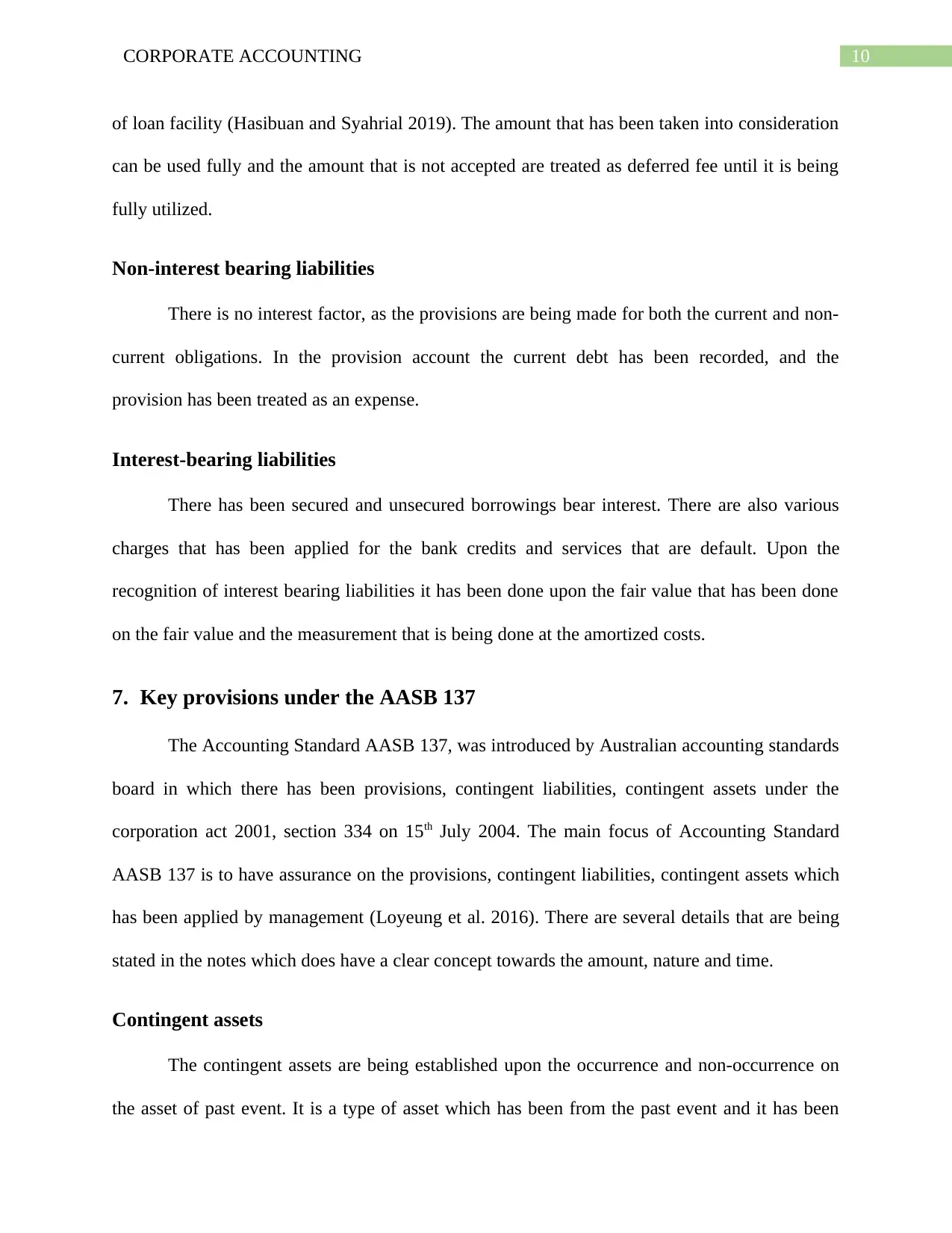
10CORPORATE ACCOUNTING
of loan facility (Hasibuan and Syahrial 2019). The amount that has been taken into consideration
can be used fully and the amount that is not accepted are treated as deferred fee until it is being
fully utilized.
Non-interest bearing liabilities
There is no interest factor, as the provisions are being made for both the current and non-
current obligations. In the provision account the current debt has been recorded, and the
provision has been treated as an expense.
Interest-bearing liabilities
There has been secured and unsecured borrowings bear interest. There are also various
charges that has been applied for the bank credits and services that are default. Upon the
recognition of interest bearing liabilities it has been done upon the fair value that has been done
on the fair value and the measurement that is being done at the amortized costs.
7. Key provisions under the AASB 137
The Accounting Standard AASB 137, was introduced by Australian accounting standards
board in which there has been provisions, contingent liabilities, contingent assets under the
corporation act 2001, section 334 on 15th July 2004. The main focus of Accounting Standard
AASB 137 is to have assurance on the provisions, contingent liabilities, contingent assets which
has been applied by management (Loyeung et al. 2016). There are several details that are being
stated in the notes which does have a clear concept towards the amount, nature and time.
Contingent assets
The contingent assets are being established upon the occurrence and non-occurrence on
the asset of past event. It is a type of asset which has been from the past event and it has been
of loan facility (Hasibuan and Syahrial 2019). The amount that has been taken into consideration
can be used fully and the amount that is not accepted are treated as deferred fee until it is being
fully utilized.
Non-interest bearing liabilities
There is no interest factor, as the provisions are being made for both the current and non-
current obligations. In the provision account the current debt has been recorded, and the
provision has been treated as an expense.
Interest-bearing liabilities
There has been secured and unsecured borrowings bear interest. There are also various
charges that has been applied for the bank credits and services that are default. Upon the
recognition of interest bearing liabilities it has been done upon the fair value that has been done
on the fair value and the measurement that is being done at the amortized costs.
7. Key provisions under the AASB 137
The Accounting Standard AASB 137, was introduced by Australian accounting standards
board in which there has been provisions, contingent liabilities, contingent assets under the
corporation act 2001, section 334 on 15th July 2004. The main focus of Accounting Standard
AASB 137 is to have assurance on the provisions, contingent liabilities, contingent assets which
has been applied by management (Loyeung et al. 2016). There are several details that are being
stated in the notes which does have a clear concept towards the amount, nature and time.
Contingent assets
The contingent assets are being established upon the occurrence and non-occurrence on
the asset of past event. It is a type of asset which has been from the past event and it has been
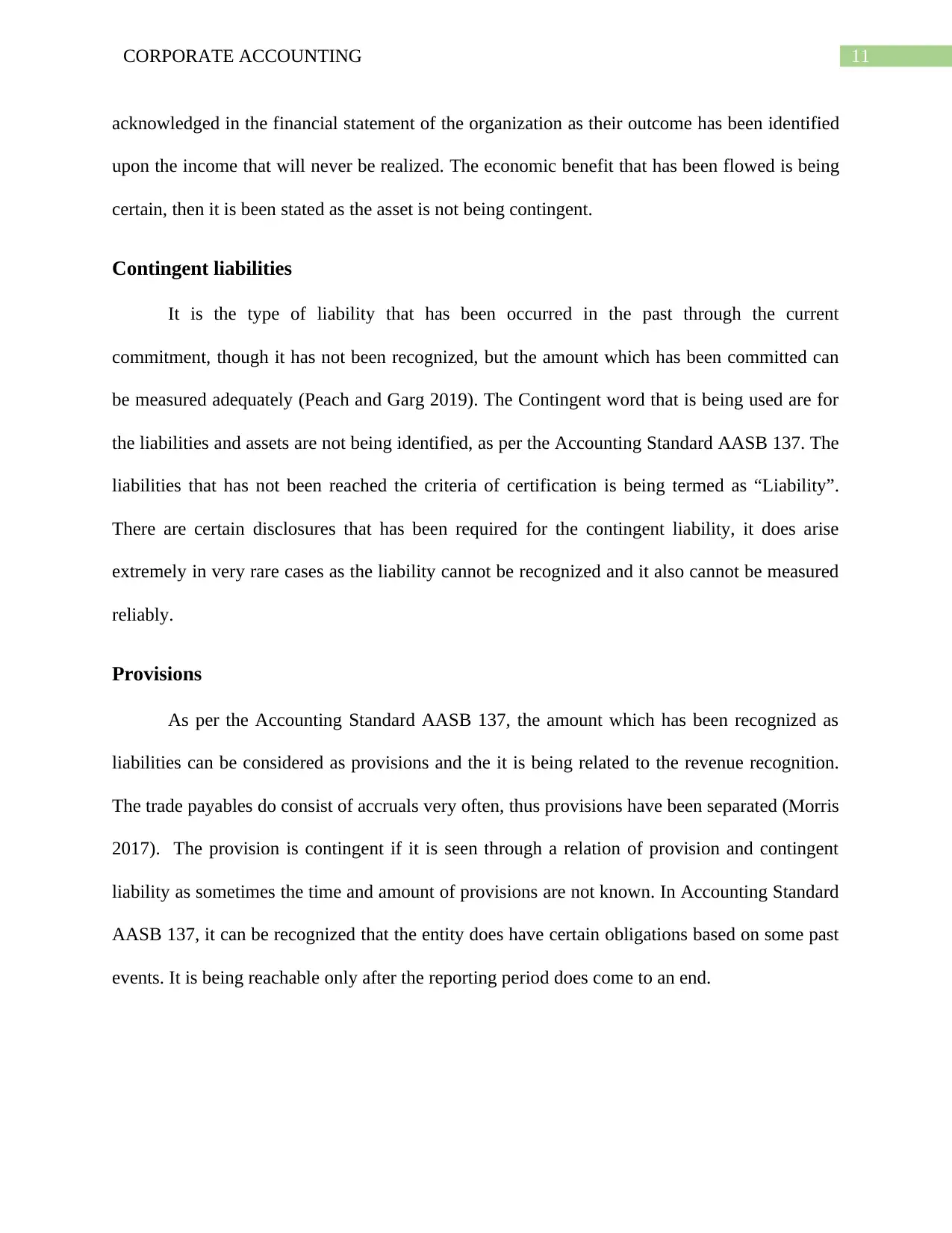
11CORPORATE ACCOUNTING
acknowledged in the financial statement of the organization as their outcome has been identified
upon the income that will never be realized. The economic benefit that has been flowed is being
certain, then it is been stated as the asset is not being contingent.
Contingent liabilities
It is the type of liability that has been occurred in the past through the current
commitment, though it has not been recognized, but the amount which has been committed can
be measured adequately (Peach and Garg 2019). The Contingent word that is being used are for
the liabilities and assets are not being identified, as per the Accounting Standard AASB 137. The
liabilities that has not been reached the criteria of certification is being termed as “Liability”.
There are certain disclosures that has been required for the contingent liability, it does arise
extremely in very rare cases as the liability cannot be recognized and it also cannot be measured
reliably.
Provisions
As per the Accounting Standard AASB 137, the amount which has been recognized as
liabilities can be considered as provisions and the it is being related to the revenue recognition.
The trade payables do consist of accruals very often, thus provisions have been separated (Morris
2017). The provision is contingent if it is seen through a relation of provision and contingent
liability as sometimes the time and amount of provisions are not known. In Accounting Standard
AASB 137, it can be recognized that the entity does have certain obligations based on some past
events. It is being reachable only after the reporting period does come to an end.
acknowledged in the financial statement of the organization as their outcome has been identified
upon the income that will never be realized. The economic benefit that has been flowed is being
certain, then it is been stated as the asset is not being contingent.
Contingent liabilities
It is the type of liability that has been occurred in the past through the current
commitment, though it has not been recognized, but the amount which has been committed can
be measured adequately (Peach and Garg 2019). The Contingent word that is being used are for
the liabilities and assets are not being identified, as per the Accounting Standard AASB 137. The
liabilities that has not been reached the criteria of certification is being termed as “Liability”.
There are certain disclosures that has been required for the contingent liability, it does arise
extremely in very rare cases as the liability cannot be recognized and it also cannot be measured
reliably.
Provisions
As per the Accounting Standard AASB 137, the amount which has been recognized as
liabilities can be considered as provisions and the it is being related to the revenue recognition.
The trade payables do consist of accruals very often, thus provisions have been separated (Morris
2017). The provision is contingent if it is seen through a relation of provision and contingent
liability as sometimes the time and amount of provisions are not known. In Accounting Standard
AASB 137, it can be recognized that the entity does have certain obligations based on some past
events. It is being reachable only after the reporting period does come to an end.
⊘ This is a preview!⊘
Do you want full access?
Subscribe today to unlock all pages.

Trusted by 1+ million students worldwide
1 out of 17
Related Documents
Your All-in-One AI-Powered Toolkit for Academic Success.
+13062052269
info@desklib.com
Available 24*7 on WhatsApp / Email
![[object Object]](/_next/static/media/star-bottom.7253800d.svg)
Unlock your academic potential
Copyright © 2020–2025 A2Z Services. All Rights Reserved. Developed and managed by ZUCOL.





